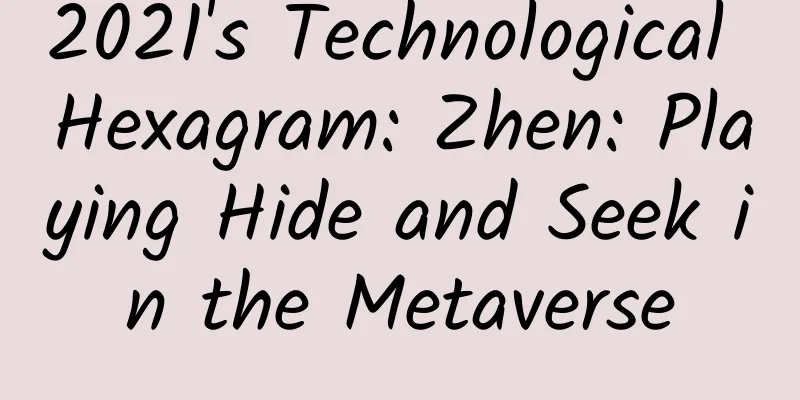2021's Technological Hexagram: Zhen: Playing Hide and Seek in the Metaverse

|
The ideas of science fiction novels are often appropriated into technology, but no word can be as powerful and unstoppable as "metaverse". After all, no one has heard of "The First Year of the Wandering Earth" or "The Force Universe". From the listing of Roblox in March to the scramble for attention from global capital and technology giants, the Metaverse, which has become famous all over the world, is a well-deserved "Zhen Gua" in the technology hexagram of 2021. Zhen means thunder, which has a huge impact and can eliminate dullness. How popular is the Metaverse? Let’s not talk about the gossip about real estate speculation groups and WeChat business selling courses. Let’s talk about PANTONE, a color research organization that has nothing to do with the pan-Internet field. Because of the rise of the Metaverse and the impact of the coronavirus lockdown, PANTONE has set the 2022 color of the year as "Very Periwinkle Blue". The reason is that this color just represents creativity, imagination and vitality. How can the Metaverse have the same global influence as COVID-19? Since it is a sudden and unusually loud "thunder", in this article, let's talk about the reasons behind thunder and the chain reactions caused by thunder. Thunderous: A Billion-Dollar Gamble It seems that the meta-universe "popped up suddenly", but just as thunder comes suddenly, behind it actually goes through a series of processes of friction, heating, expansion and vibration between two clouds. The meta-universe has also been brewing for a long time. In 1992, Neal Stephenson proposed the concept of "metaverse" in his science fiction novel Avalanche; in 2019, Kevin Kelly also described a large-scale digital twin technology platform in Welcome to the Realm. These imaginations are consistent with people's definition of the metaverse today - a virtual world that simulates the real world 1:1 and is always online and permanent. But why does the Metaverse seem to have appeared out of nowhere and even made it into multiple annual hot words and buzzword lists? Let’s first briefly review the timeline. 1. Warming-up period. In March 2021, Roblox, the "first stock in the metaverse", landed on the Nasdaq and saw a surge. Global technology companies quickly followed suit. In April, Epic Games raised $1 billion from investors such as Sony to create its own "metaverse"; in May, Microsoft CEO Satya Nadella said the company was working to build an "enterprise metaverse"; in August, Nvidia launched the world's first metaverse simulation and collaboration platform Omniverse, and ByteDance spent a huge amount of money to acquire VR startup Pico. 2. Expansion period. On October 28, 2021, the American technology giant Facebook announced that it would change its name to "Meta" and change its stock code to MVRS. Under the hype, the "Metaverse" attracted outside attention and "went out of the circle". In addition to technology and Internet companies that began to actively follow up, Baidu released the Metaverse product "Xiran", NetEase released two Metaverse solutions, and Ubisoft announced the Ubisoft Quartz project, officially entering the Metaverse and NFT... At the same time, many companies in traditional fields also participated. Fashion brand Balenciaga announced the creation of a "Metaverse" department to explore virtual world marketing, meat products company Shuanghui registered the "Native Universe" trademark, and Zhangjiajie Scenic Area established the Zhangjiajie Metaverse Research Center. (Metaverse Embassy of the Barbados Government) 3. Fluctuation period. There must be undercurrents under the heat. Chaos such as "house speculation groups" and micro-business courses have emerged. At the end of the year, countries with a large number of metaverse industries have started the "difficult" action of accelerating while controlling chaos. In terms of policy, Seoul, the capital of South Korea, announced in November this year that it would become the first city government to join the metaverse, encouraging Samsung, Hyundai Motor, LG and other companies to form a "Metaverse Alliance"; Zhejiang Province, China invested 7.84 billion yuan to build a metaverse base in Keqiao. Regarding the "hype" that has caused heated discussions, some entities have also continuously issued warnings in order to standardize development. On December 9, the People's Daily published a commentary reminding the public that the metaverse "is a gradual development process, beware of the risk of burns from being overheated." Since the term "metaverse" is not a new one, why has it become so popular this year? It can be summarized into three psychological reasons. 1. It is easy to fish in troubled waters. The concept of the metaverse is grand and the trend is far-reaching, leaving enough room for capital, media, and enterprises to play. To this day, there is no exact definition of the metaverse that is widely agreed upon. Tsinghua University's 2021 Metaverse Research Report simply defines the metaverse as a fusion of a series of technologies: "massively multiplayer online games + open tasks + editable worlds + XR portals + AI content generation + economic systems + social systems + avatar systems + decentralized authentication systems + reality elements." The lack of a unified standard means that you can interpret it however you want. The brokerage firm has made another big prediction, predicting that by 2025, the market space for the Metaverse in the fields of social networking, games, short videos, mobile office, etc., will be about 340 billion to 640 billion yuan in China alone. Putting the Metaverse label on the product can attract a wave of attention, as if your worth has increased, so why not do it? 2. Save the children. Amid the recurring global epidemic, economic pressures in various countries, antitrust scrutiny and strict privacy laws, and the peak of traffic dividends, technology giants are also in need of a breakthrough. Facebook's name change is also related to increasingly stringent supervision and rapidly declining user reputation. After the metaverse concept became popular, VR and AR, which were promising entry points and supporting devices, finally became active again after several years of silence, ushering in a new wave of investment after 2014 and 2015. NOLO VR completed a $20 million Series B financing, iQiyi Smart completed a financing of hundreds of millions of yuan, and Feidie VR Technology completed a financing of tens of millions of yuan... Although only Oculus Quest 2 has really pried open the consumer market for VR headsets, and it has only attracted some game enthusiasts, and there is still debate about whether VR is the entrance to the metaverse (the brain-computer interface is also waiting in the wings), at least VR/AR, which has been neglected for a long time, has a new story to tell, which is enough to boost enthusiasm. Therefore, some foreign media believe that the popularization of the "metaverse" is an investment rescue for some companies' failed technologies. 3. Getting bored. After the epidemic, digital life that integrates the real and the virtual has accelerated. People are unable to move freely around the world, and many work and life have to be completed in the virtual world. This has made many people begin to believe and accept that the "metaverse" may really exist. Zuckerberg himself also mentioned in an interview that the epidemic has proved that people can work in front of computers for 8 hours, and TV/streaming/video games are also virtual worlds, so the demand for the immersive virtual experience provided by the metaverse is real. Maybe you will say, isn’t surfing the Internet enough? Why do we need to come up with a new concept? Let’s think carefully. In the past two years, the digital world built by the Internet has become more and more physical. Social networks have become a reflection of real relationship networks. The short video you just posted may be recommended by algorithms to your second aunt who is far away in your hometown. The Internet has become the infrastructure to support the development of the real industry and has begun to "move from virtual to real". There has been no disruptive innovation in the consumer Internet field for a long time. Almost all the apps ranked at the top of the application market were invented in the last decade. Everyone’s spiritual life in the digital world is becoming more and more boring, and the large virtual "playground" described by the metaverse is indeed attractive to many netizens. (Fortnite, one of the representatives of the Metaverse) Although the current level of technology determines that the real metaverse is impossible to realize and is still in the "imagination stage"; the content and details disclosed by various companies are very limited, either VR meetings or virtual parties, and no disruptive products and business models have appeared. However, driven by various people and various psychological factors, the metaverse is like a thunderclap, shocking countless people: "What happened?!" Little rain: a long drought is hard to come by In the context of us pragmatic Chinese people, when we look forward to thunder, what we essentially hope for is the rain that will fall after the thunder, nourishing the growth of various crops. "Thunder without rain" is somewhat derogatory. So, did the thunder of the metaverse bring the precious spring rain? Unfortunately, apart from the deception, only two or three drops of rain actually fell to the ground. On the one hand, the gradual development of existing technologies. In addition to the VR/AR mentioned above, other technologies that are considered to be the underlying support of the metaverse, such as artificial intelligence, digital twins, blockchain, cloud computing, robotics, brain-computer interfaces, 5G, etc., must adapt to the stage of industrial development and iterate under the drive of real needs such as games, applications, and industry. At the same time, many metaverses are secondary packaging of traditional applications and services, and have not brought incremental demand. For example, the so-called "medical metaverse", through virtual reality wearable devices and AI imaging, doctors can see the patient's physiological structure for remote consultation, and give pathology and treatment plans. It was implemented in the prevention and control of the new crown as early as 2019. "Marketing metaverse", virtual idols endorse brands, game IP implant marketing plans, used to be called "two-dimensional linkage" and "breaking the dimensional wall", and now it is "metaverse". Meta, the most powerful one, recently launched the metaverse application Horizon Worlds, where users can use virtual images with only half of their bodies for leisure and social interaction, but the experience is not good; Horizon Workrooms uses VR equipment to place a whiteboard on the virtual desktop in the meeting for writing, but the efficiency is not ideal. So, what can truly drive the growth of all things and help accelerate the arrival of the metaverse? 1. Establishment of standards. Existing digital pillars such as communication networks, Internet technologies, storage technologies, and computing centers are not designed for the Metaverse, and the iteration and adaptation of infrastructure will take a long time. For example, transactions within the Metaverse rely on blockchain and cryptocurrency, which are under controversy and regulation, and how they will develop in the future remains unknown. 2. Popularization of headsets. So far, VR headsets are still the key carrier for most people to access and imagine the metaverse, but VR headsets still have problems such as mismatched supply and demand, low prices, and insufficient penetration. Not everyone has a VR headset, so it is naturally difficult to form a large-scale ecosystem like desktop PCs and mobile Internet. (Global VR Headset Device Forecast) 3. Developer participation. A rich and colorful Metaverse experience requires a wide range of software and application support with unlimited creativity. Currently, developers can only develop through platforms or operating systems built by VR manufacturers, which almost do not support collaborative interaction and synchronous development with the Internet of Things, smart devices, and Internet of Vehicles. Naturally, a perfect Metaverse experience does not exist. At least for now, it seems that the metaverse will face the drying up of its growth soil for a long time. Hide and Seek: The Ultimate Human Game Of course, we are not here to criticize the Metaverse. In fact, from a logical point of view, the picture depicted by the Metaverse should be the fate of all mankind. First, the integration of virtual and real has begun, and humans have begun to migrate from the offline world to the digital world on a large scale. According to CNNIC data, China already has more than 1 billion Internet users. After the epidemic, the time spent online has increased significantly, and digital life has become the norm, which means that once the virtual world of the metaverse is opened, it will be easy to attract "new residents." Imagine the scene of everyone calling their friends to "go to the island" after the popularity of "Animal Crossing." Secondly, intelligent technology creates idle people who have no need or ability to participate in production, and their spiritual needs are met through the virtual world. The World Economic Forum's "Future of Work" mentioned that the reduction in manpower caused by technology will lead to the loss of 7.1 million jobs in developed countries in the next five years, but 2.1 million jobs will be created in the fields of technology, professional services and media. With the two offsetting each other, there will be a net loss of 5 million jobs in the next five years, mainly in administrative work and white-collar workers. In general, more and more people will become the "abandoned people" of technology. Yuval Noah Harari believes that in the future there will be a huge group of people who have no jobs, no goals, and spend their days wearing VR helmets. And they are the "demographic dividend" of the metaverse. The game "Oasis" in "Ready Player One" has always been the preferred analogy of the metaverse, and it is precisely because the protagonist is a low-level person who escapes reality through games. Of course, don’t think this is a tragic thing. Liu Cixin once described a completely virtual "invisible world" in "Time Migrants" where people can really do whatever they want and create everything they want. "You can create an empire with a population of 100 billion, where you are the king; you can experience a thousand different romances, and die 100,000 times in 10,000 wars; there everyone is the master of a world, more powerful than God. You can even create a universe for yourself, with hundreds of millions of galaxies in that universe, and each galaxy has hundreds of millions of planets, and each planet is a different world that you desire or dare not desire!" Once you have experienced such a life, the real world full of troubles is like hell. "Amusing Ourselves to Death" mentioned that in the age of television and the Internet, people are becoming more and more fond of browsing information, with their heads full of ideas without having to take any action. The world of high-speed flow and discontinuity of information is a world that does not require or allow us to do anything, a world that is completely closed like a game of hide-and-seek. Of course, like hide-and-seek, it is also endless fun. This is also the future that the Metaverse may bring us, an ultimate game of hide-and-seek. If you don’t believe it, think about whether there are more people who like to stay at home and review their friends’ circles, watch short videos, and comment on social media, or whether there are more people who like to go out for a meal with friends and have a hand-in-hand love affair? Perhaps for the "metaverse natives", there is no need to make any choice. But for you and me who grew up in the physical world, whether we will choose to enter the virtual metaverse and find solace in the digital world, or open up more real space to keep real encounters between people as much as possible, has never been so confusing. In 2021, known as the “Year One of the Metaverse,” we hear the rumbling of thunder. As science fiction writer William Gibson said: The future is already here, it’s just not evenly distributed. |
<<: Everything can be "hyaluronic acid"
Recommend
Google starts testing voice payment. Can you really pay with your mouth?
With the advancement of technology, the means of ...
Netgear has launched a new product line, the Orbi, which can split into two parts. Will it attract you if you don’t have a house?
If someone tells you, "My router is NETGEAR....
The latest version of Android supports FIDO2 standard for password-free login to apps or websites
Google has just announced a new collaboration wit...
What exactly are user insights? How to do it?
I often hear people compare marketing to "te...
How to buy traffic and acquire users on Douyin at low cost?
Tik Tok is still in its wild growth period, with ...
iOS 15 is coming soon: a bunch of new features
iOS 15 release date: September 2021 Apple release...
Yellow fog warning! Please pay attention when traveling →
According to the website of the Central Meteorolo...
Details of ZUK phone revealed, is it going to be an Android version of iPhone?
"If the ZUK phone and the next generation iP...
Interpreting ASP.NET 5 & MVC6 Series (3): Project Release and Deployment
In this chapter, we will explain the content rela...
Do you have these 5 smells at home? Strange smells at home are really dangerous!
One minute with the doctor, the postures are cons...
5 common methods to improve user retention!
In the current context where it is difficult and ...
Tiantian Kuaibao Competitive Product Analysis | How to increase user stickiness?
Preface The creation background of this competiti...
What is the difference between three-dimensional space and four-dimensional space? How to understand it? Does higher-dimensional space really exist?
This question is actually very simple. Three-dime...
Why Apple's licensing of its iOS operating system was a bad move
In response to the declining sales of Apple iPhon...
Xi'an sauna massage release
Content: Xi'an tea friends resource sharing a...









